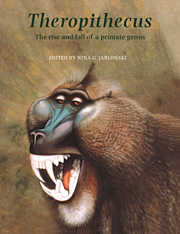Book contents
- Frontmatter
- Contents
- List of Contributors
- Preface
- Acknowledgements
- 1 Introduction
- PART I Fossil evidence and phylogeny
- PART II Biogeography and evolutionary biology
- PART III Anatomy of the fossil and living species of Theropithecus
- PART IV Behaviour and ecology of living and fossil species of Theropithecus
- 15 Social organization of the gelada
- 16 The ecology of Theropithecus gelada
- 17 Food digestion and energetic conditions in Theropithecus gelada
- 18 Socioecology of the extinct theropiths: a modelling approach
- 19 Ecological energetics and extinction of giant gelada baboons
- Appendix I A partial catalogue of fossil remains of Theropithecus
- Appendix II Conservation status of the gelada
- Index
17 - Food digestion and energetic conditions in Theropithecus gelada
Published online by Cambridge University Press: 11 November 2009
- Frontmatter
- Contents
- List of Contributors
- Preface
- Acknowledgements
- 1 Introduction
- PART I Fossil evidence and phylogeny
- PART II Biogeography and evolutionary biology
- PART III Anatomy of the fossil and living species of Theropithecus
- PART IV Behaviour and ecology of living and fossil species of Theropithecus
- 15 Social organization of the gelada
- 16 The ecology of Theropithecus gelada
- 17 Food digestion and energetic conditions in Theropithecus gelada
- 18 Socioecology of the extinct theropiths: a modelling approach
- 19 Ecological energetics and extinction of giant gelada baboons
- Appendix I A partial catalogue of fossil remains of Theropithecus
- Appendix II Conservation status of the gelada
- Index
Summary
Summary
A hypothesis of hindgut fermentation of gelada (Theropithecus gelada) was examined by assessing the ability of animals to digest crude fibre in foods and by evaluating the extent of bulk eating in the dry season.
Three caged geladas could digest more than 50 per cent of the crude fibre content of rations; this suggests that gelada have a microbial fauna to decompose fibre in the hindgut (caecum and/or colon).
Gelada living in the Gich area of the Simen Mountains significantly increased their food intake going into the dry season. This was brought about by changing their food eating habits from grasses to the herb, Trifolium, and by prolonging the time spent feeding.
The quality of food eaten, however, did not decrease in the dry season, because of the high nutritional content of Trifolium. This indicates that geladas do not fully satisfy the condition stated by Janis (1976) that animals employing hindgut fermentation increase their bulk food intake when faced with lowered food quality.
The greater energy intake in the dry season might be explained by factors such as the need for more food for body temperature regulation during the cold dry season, lessened ability to digest Trifolium, the toxin content of Trifolium, or sampling error.
It is suggested that further studies on the digestive physiology of geladas are necessary to understand the evolution of Theropithecus to such a highly specialized food habit.
Introduction
Some folivorous primates have developed fermentation chambers in the gut to enable them to extract more nutrients and energy from low quality food than would be possible without such a specialization of the digestive apparatus (Bauchop, 1978).
- Type
- Chapter
- Information
- TheropithecusThe Rise and Fall of a Primate Genus, pp. 453 - 464Publisher: Cambridge University PressPrint publication year: 1993
- 2
- Cited by

